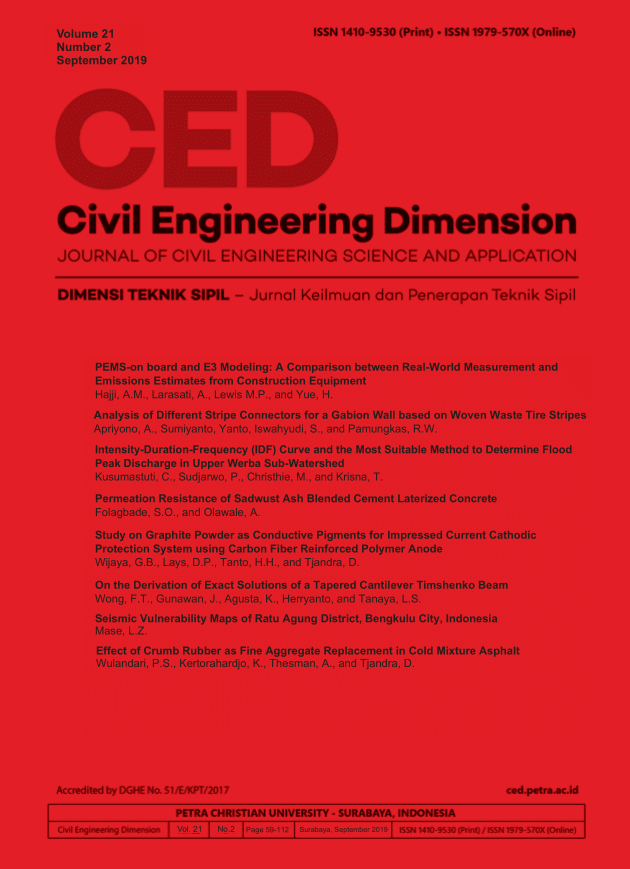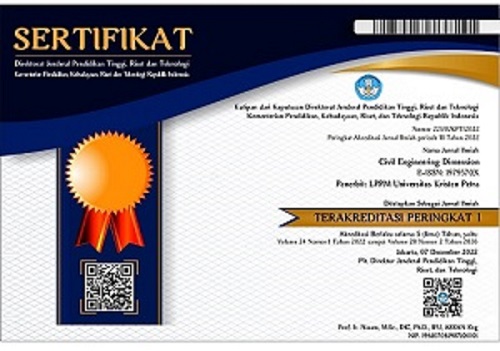Study on Graphite Powder as Conductive Pigments for Impressed Current Cathodic Protection System using Carbon Fiber Reinforced Polymer Anode
 :
:
https://doi.org/10.9744/ced.21.2.84-88
Keywords:
Carbon fiber reinforced polymer laminate, graphite powder, half cell potential, impressed current cathodic protection system, pull-off test.Abstract
The use of Carbon Fiber Reinforced Polymer (CFRP), for both strengthening material and anode for Impressed Current Cathodic Protection (ICCP) system, is being investigated. The focus of this study is to develop the epoxy that has good bond strength and electrical conductivity. Graphite powder is used as conductive pigments with percentage ranges from 7.5% to 17.5%. All specimens were partially submerged in 5% NaCl solution and induced with electrical current of 10 mA/m2 and 20 mA/m2 for 30 days. An average potential increase of 200 mV was recorded using half cell potential test. The application of 30 days ICCP up to current density of 20 mA/m2 did not affect the bond strength significantly and still complies with ACI recommendation. However, graphite content of more than 15% are found to be not workable and the bond strength is greatly reduced to less than 1 MPa This study concluded that the recommended graphite powder content shall be in the range of 10% to 15%.References
FHWA-RD-096, Long Term Effectiveness of Cathodic Protection Systems on Highway Structures, Federal Highway Administration Research and Development, McLean, VA, USA, 2001.
Gadve, S., Mukherjee, A., and Malhotra, S.N., Active Protection of Fiber-reinforced Polymer-wrapped Reinforced Concrete Structures Against Corrosion, Corrosion, 67(2), 2011, pp. 25002–25011.
Lu, Y., Hu, J., Li, S., and Tang, W., Active and Passive Protection of Steel Reinforcement in Concrete Column Using Carbon Fibre Reinforced Polymer Against Corrosion. Electrochimica Acta. Vol. 278, 2018, pp. 124–136. https://doi. org/10.1016/j.electacta.2018.05. 037
Nguyen, C.V., Mangat, P.S., Lambert, P., O’Flaherty, F.J., and Jones, G., Dual Function Carbon Fibre Reinforced Anode System for Concrete Structures. Materials and Structures. 48(7), 2014, 2157–2167. https://doi.org/10.1617/ s11527-014-0300-0
Bahekar, P.V., and Gadve, S.S., Impressed Current Cathodic Protection of Rebar in Concrete Using Carbon FRP Laminate. Construction and Building Materials, 156, 2017, pp. 242–251. https://doi.org/10.1016/j.conbuildmat.2017. 08.145
Broomfield, J.P., Corrosion of Steel in Concrete: Understanding, Investigation and Repair, Second Edition, CRC Press, London, UK, 2006.
Wilson, K., Jawed, M., and Ngala, V., The selection of Cathodic Protection Systems for the repair of Reinforced Concrete Structures, Construction and Building Materials, Elsevier, 39, 2013, pp. 19-25,
British Standards Institution, BSI Standards Publication Cathodic Protection of Steel in Concrete (ISO 12696 : 2012). United Kingdom: BSI Standards Limited, 2012.
ASTM C876, Standard Test Method for Half-Cell Potentials of Uncoated Reinforcing Steel in Concrete, ASTM International, West Conshohocken, PA., USA, 2015.
ASTM C1583, Standard Test Method for Tensile Strength of Concrete Surfaces and Bond Strength or Tensile Strength of Concrete Repair and Overlay Materials by Direct Tension (Pull-Off Method), ASTM International, West Con-shohocken, PA., USA, 2013.
ACI 440.2R, Guide for the Design and Construction of Externally Bonded FRP Systems for Strengthening Concrete Structures, ACI Committee 440,, Farmington Hills, MI., USA, 2017.
Ahmad, S., Techniques for Inducing Accelerated Corrosion of Steel in Concrete. Arabian Journal for Science and Engineering, 34(2), 2009, pp. 95–104.
Downloads
Published
How to Cite
Issue
Section
License
Authors who publish with this journal agree to the following terms:- Authors retain the copyright and publishing right, and grant the journal right of first publication with the work simultaneously licensed under a Creative Commons Attribution License that allows others to share the work with an acknowledgement of the work's authorship and initial publication in this journal.
- Authors are able to enter into separate, additional contractual arrangements for the non-exclusive distribution of the journal's published version of the work (e.g., post it to an institutional repository or publish it in a book), with an acknowledgement of its initial publication in this journal.
- Authors are permitted and encouraged to post their work online (e.g., in institutional repositories or on their website) followingthe publication of the article, as it can lead to productive exchanges, as well as earlier and greater citation of published work (See The Effect of Open Access).

















